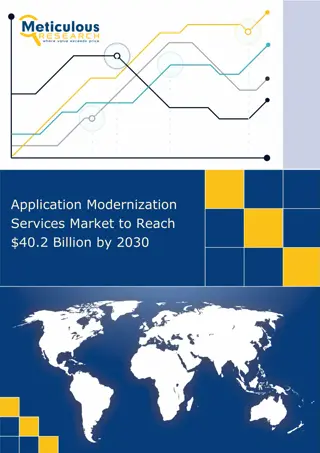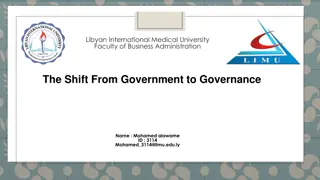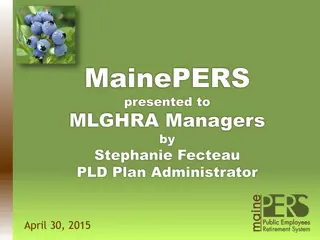Enterprise Architecture: Modernization and Governance Overview
Understanding Enterprise Architecture, its benefits, and the importance of modernization in the context of federal compliance with Medicaid standards. Governance practices and the service-oriented approach are highlighted to drive organizational, operational, and system design frameworks.
Download Presentation

Please find below an Image/Link to download the presentation.
The content on the website is provided AS IS for your information and personal use only. It may not be sold, licensed, or shared on other websites without obtaining consent from the author.If you encounter any issues during the download, it is possible that the publisher has removed the file from their server.
You are allowed to download the files provided on this website for personal or commercial use, subject to the condition that they are used lawfully. All files are the property of their respective owners.
The content on the website is provided AS IS for your information and personal use only. It may not be sold, licensed, or shared on other websites without obtaining consent from the author.
E N D
Presentation Transcript
ENTERPRISE ARCHITECTURE Office of Technology Services Matthew Vince, PMO
OVERVIEW I. What is Enterprise Architecture? II. Governance III. Technology IV. Team V. Appendix
BENEFITS Decreased time and cost for procurements with standardized hardware and software requirements and specifications Can work with custom built or Commercial of the Shelf (COTS) software Decreased administrative costs with available cost-allocation tools delivered as part of the solution Improved SLA metrics and enforcement Reduced overall operating costs for software and hardware Improved, standardized security and event monitoring Increased reliability and performance by using reusable components
LDH MODERNIZATION HOW WE ARRIVED HERE Required for Federal compliance with Medicaid standards Guidance and rules from CMS and other Federal partners provide for: Service Oriented Architecture (SOA) Modular Development No Monoliths , no Big Bang implementations Agile procurement, development, and release methodologies Needed to support the Medicaid Modernization (replacement of their core Medicaid systems: Eligibility/Enrollment, Provider Management, MMIS, et al.)
WHAT IS ENTERPRISE ARCHITECTURE? It is an organizational, operational, and system design framework Service oriented approach Service provider model Service oriented architecture (SOA) Break systems down into modules with specific responsibility Business requirements drive technical decisions Overall design roadmaps and strategic planning Cost allocation, billing, and reporting Guidelines and support for all methods of system development custom, hosted, COTS, Software as a Service (Saas) EA is the future vision for the State based on open standards. EA puts the State in a position to provide improved service and flexibility. Silo or Monolith systems can no longer be supported.
IT GOVERNANCE Value can be recaptured through shared-service initiatives such as consolidating data centers, modernizing the IT infrastructure, better utilizing capacity, pooling IT staff, sharing best practices, consolidating procurement, and managing demand through central governance. IT service management must continue to align itself with the attitude of generating the maximum benefit for the agency and State as a whole. Operations lifecycle - Information Technology Infrastructure Library (ITIL): Problem and Incident Management, Change Management, Onboarding, Release Management, Request Fulfillment, Availability Management
FEDERAL CIO DIGITAL SERVICES PLAYBOOK Today, too many of our digital services projects do not work well, are delivered late, or are over budget. The American people expect to interact with government through digital channels such as websites, email, and mobile applications. By building digital services that meet their needs, we can make the delivery of our policy and programs more effective. Playbook of 13 plays drawn from successful private sector and government practices https://playbook.cio.gov/ - Digital Services Playbook
THE PLAYS FOR EA Plays Approach Build the service using agile and iterative practices Promotion of new software development lifecycle approaches and tools Choose a modern technology stack Private + Public cloud, hyper- converged Deploy in a flexible hosting environment Introduction of automated security testing Automate testing and deploys Manage security and privacy through reusable processes Single Sign On and Identity Management Data Warehouse, reporting, interoperability + Big Data future Use data to drive decisions
THE OPEN GROUP ARCHITECTURE FRAMEWORK (TOGAF) Maximize Benefit to the Enterprise, Information Management is Everybody's Business, Business Continuity, Common Use Applications, Compliance with Law, Data is an Asset, Data is Shared, Data is Accessible, Data Trustee, Data Security, Technology Independence, Ease-of-Use, Requirements-Based Change, Responsive Change Management, Control Technical Diversity, Interoperability The How To manual for Enterprise Architectures Provides a set of 20 principles for an enterprise architecture Organization comprised of over 200 enterprises As of 2016, is employed by 80% of Global 50 and 60% of Fortune 500 Based on over 20 years of combined IT experience
COST ALLOCATION AND BILLING Sample Metrics (still in development) Able to comply with any federal or state cost allocation principles Included in SWiCAP as part of OTS catalog and reviewed by federal partners for OMB Circular A87 compliance Number of documents stored in document management system Number of emails sent from consumer communications Execution time of business rules Costs are based on actual usage of EA components, not around specific personnel, hardware, or software components There will be no bill for EA support personnel Number of external and internal users
AT THE CORE Core Components Ancillary Functions Identity and Access Management & Single Sign On Monitoring and Alerting Application Performance Monitoring What is the customer seeing? Master Data Management Data Warehouse Real time security and log monitoring Business Rules Engine Requirements and issue tracking Consumer Communications Disaster recovery Electronic Document Management Automation Enterprise Service Bus Many more
PLATFORM Two complete systems spanning two datacenters Plans for future expansion into public cloud space (Amazon, Microsoft, etc.) Creates a highly available environment 99.99% uptime Hyper-Converged technology Modern-day infrastructure to support highly transactional and enterprise level systems Can scale up and out as needed, at reduced costs
THE PLAYS FOR EA Plays Build the service using agile and iterative practices Choose a modern technology stack Deploy in a flexible hosting environment Automate testing and deploys Manage security and privacy through reusable processes Use data to drive decisions
AGILE PRINCIPLES FOR SYSTEM DEVELOPMENT Core Tenets Principles Our highest priority is to satisfy the customer through early and continuous delivery of valuable software. Individuals and interactions over processes and tools Working software over comprehensive documentation Working software is the primary measure of progress. Simplicity - the art of maximizing the amount of work not done - is essential. Customer collaboration over contract negotiation At regular intervals, the team reflects on how to become more effective, then tunes and adjusts its behavior accordingly. Responding to change over following a plan http://agilemanifesto.org
TECHNOLOGY STACK Lower the learning curve Lower the barrier of entry for a developer joining a new team Easier to utilize existing staff on different teams if they do not have to learn new technologies Security Easier to test and maintain security on a smaller stack Cost Shared costs between agencies on technology purchases Better pricing in bulk by vendors
DEVOPS Continuous Integration Delivery Deployment Learning Improvement DevOps is the union of people, process, and products to enable continuous delivery of valueto our end users. - Donovan Brown, Microsoft Shifting Left Getting feedback to developers while the idea is still fresh in their mind.
AUTOMATED TESTING Automated testing saves time and money, improves accuracy, and enables faster delivery of software. Unit Testing Testing the units of code, on every build, to know that bugs are not introduced by changes made. User Interface Testing Script out the common tests that cover most of the work so that your testers can actually concentrate on what changed. Security Testing Introduce security testing of the code and the applications at every stage to keep ourselves and our constituents protected.
SECURE APPLICATION DEVELOPMENT Protect applications across the entire Software Development Lifecycle Test in development Test pre-production environments Test production environments Developing Application Security Standards Reduce Costs Shifting the security issues to the developers immediately after writing code both helps them to fix it as well as learn from their mistakes while in context of what that issue was.
DATA-DRIVEN DESIGN Metrics and measurements are critical aspects to determining value When you can measure what you are speaking about, and express it in numbers, you know something about it, when you cannot express it in numbers, your knowledge is of a meager and unsatisfactory kind; it may be the beginning of knowledge, but you have scarcely, in your thoughts advanced to the stage of science. In order to deliver value, you have to measure that you have in fact delivered value Knowing that users are actually using the feature that was just deployed Understanding how users are using the system. - William Thomson, 1st Baron Kelvin
THE EA TEAM Network Operations Center (NOC) Extension of End User Computing and Helpdesk operations Front line monitoring and incident response Actions are dictated by you the customer: how, when, and to whom to report and respond Enterprise Technical Architect Enterprise Governance Architect Enterprise Applications Architect Enterprise Security Architect Component and Technology Leads
ACCOLADES & PRESS Press Awards and Speaking Engagements CA: Louisiana Transforms State Gov for the Digital Era 2016 CA World VIP Award Winner 2017 StateScoop 50 Award Winner GCN: How one state's modernization delivers service transformation 2016 GCN Dig IT Awards Finalist 2016 Splunk Public Sector Innovation Awards Finalist GovTech: New Hyper-Converged Platform, Cloud Architecture Streamline Louisiana IT, Health Care 2016, 2017 CA World speaker and panelist Deloitte Press: Inevitable architecture: Complexity gives way to simplicity and flexibility - Future stack: Louisiana builds an IT architecture for tomorrow 2016 Splunk Public Sector panelist 2016, 2017 VMWorld speaker and panelist Yahoo News: State of Louisiana Builds Technology 'Systems of Tomorrow' with VMware NSX 2017 ISACA panelist 2017 MESC speaker StateScoop: Software-defined, cloud-based and virtualized: Louisiana's new data center does it all
CORE COMPONENT STACK Identity Management/SSO - CA Identity Manager/Suite and SSO Data Warehouse & Reporting - Hitachi Pentaho Master Data Management - Information Builders OmniGen Electronic Document Management - IBM Filenet Business Rules Engine - IBM Decision Center Enterprise Service Bus - Software AG WebMethods Consumer Communications - HP/OpenText Exstream
SUPPORTING SOFTWARE Nagios Infrastructure Monitoring and Alerting New Relic Application Performance Monitoring (APM), Real User Monitoring (RUM) Splunk Operational Intelligence GitHub Enterprise Source Code Repositories Bamboo Continuous Integration (CI), Deployment (CD), and Delivery Puppet DevOps, Automation, Configuration Mangement JIRA Issue and Project Tracking Jama Requirements Tracking and Control McAfee Enterprise Security Manager - Security Information & Event Manager IBM Workload Scheduler - Job Scheduling MoveIT - Enterprise Managed File Transfer Orbus iServer - Strategic Planning and Enterprise Architecture Modeling Commvault - Disaster Recovery and Backup HP Fortify Security Testing and Scanning Microsoft SQL Server Enterprise Database System
DEEPER LOOK: ENTERPRISE SERVICE BUS Vision Business Use Case The Enterprise Service Bus (ESB) is used to route and transform message requests from a requesting application to the other six Enterprise Architecture components or external applications. The Software AG webMethods product delivers the implementation of the ESB for the State of Louisiana EA Solution, providing functionality for service discovery and mediation, rapid service development and deployment, along with API Management and governance. Systems Integration Integrating disparate systems and applications through web services and adapters to exchange information. Mediation & Security Decoupling of service consumers from the native service implementation through service virtualization. A virtual service is an enriched copy of the native service and acts as the consumer-facing proxy. The out-of-the-box virtual service enrichment capabilities include service security policies, policy enforcement, monitoring and control API Management - Manage the entire process of planning, designing, developing, and monetizing APIs and services. Govern the life cycle of APIs, services and associated policies. Services Registry/Repository Leverages a UDDI-based Services metadata registry and the Service Lifecycle Model. Monitoring - Round-trip performance monitoring of APIs and back-end services. Graphically analyze the impact of changes to the APIs. Notification of specific events and alerts.
DEEPER LOOK : IDENTITY AND ACCESS MANAGEMENT Vision Business Use Case Authentication - CA SSO enforces requirement for user authentication when a user attempts to access a resource that is protected by CA SSO. The identity and access management (IAM) solution provides user authentication and authorization capability using CA SSO component and provides user account management capability such as user account creation, password management and self-service capability using CA IDM component. Authorization - CA SSO enforces authorization policies on resources protected by IAM/SSO solution. Authenticated users are allowed to access a protected resource only if they are also authorized to access the resource. User Identity provisioning - The CA IDM solution will create and update user account for external users such as citizens and business partners in external facing EA user store. The solution will provision internal users to application specific user database for application specific access Self-Service Access and Account Management - The CA IDM solution provides the capability for users to initiate access request for specific application and perform self-service password management functions such as password reset, change password and forgot user ID. The two primary components of the EA IAM solution are Single Sign-On (SSO) and IDM (Identity Management).
DEEPER LOOK: BUSINESS RULES ENGINE Vision Business Use Case The Business Rules Engine (BRE) is used to automate the logic of making business decisions. The IBM Operational Decision Manager (ODM) product delivers the implementation of the BRE for the State of Louisiana EA solution, providing functionality for authoring, testing, and publishing business rules, as well as offering auditing capabilities and support for a high availability approach. The IBM Operational Decision Manager (ODM) provides functionality for authoring, testing, and publishing business rules. It also provides tools for monitoring and has support for a high availability approach. Vocabulary Definition Users can define a business vocabulary and add new elements to existing vocabularies to suit changing business requirements. Rule Authoring Allows business users and developers to author business rules and publish rules. Testing and Simulation Allows users to run test scenarios against the business rules using both mock data and live data. Role-Based Access Security features allow for separation of users into groups and allow role-based access to functionality. Auditing Capabilities Logs all decisions into a data-base, allowing users to see all rules that were involved in making a decision.
DEEPER LOOK: ELECTRONIC DOCUMENT MANAGEMENT Vision Business Use Case Data Capture Allows documents to be ingested into a single repository from various sources The Electronic Document Management System (EDMS) Component selected for Louisiana s EA Solution is the IBM FileNet Content Platform Engine. The IBM FileNet P8 platform offers enterprise-level scalability and flexibility to handle the demanding content challenges, the complex business processes, and the integration to other EA components and State external systems. Indexing Supports the indexing of the ingested documents with metadata properties to become easily searchable Document Search Enables the ability to search the ingested documents based on metadata and text Version Control Enhances document management by allowing document versioning to create multiple versions of a document Integration Easily allows integration with other systems using APIs Auditing Provides the ability to capture audit logging for sensitive documents Retention Policy Enables the ability to support records management to comply with regulatory guidelines
DEEPER LOOK: MASTER DATA MANAGEMENT Vision Business Use Case Multi-Domain Supports data integration of multiple data domains. The Master Data Management (MDM) Component software selected for Louisiana s EA Solution is the Information Builders Incorporated (IBI) Omni-Gen Master Data Edition. The Omni-Gen MDM platform offers the State a robust platform to create, maintain, link, and exchange subject domain records within a centralized repository. Data Quality & Mastering Supports Cleanse, Match and Merge Rules to identify data quality issues and create mastered data. Data Stewardship Provides a user interface for Data Stewards to remediate data quality issues and manage the mastered data. Centralized Data Provides a centralized repository to combine data from of trusted data for use by enterprise applications. Service Oriented Architecture (SOA) Provides services to integrate agency applications with the mastered data.
DEEPER LOOK: DATA WAREHOUSE Vision Business Use Case Business Intelligence Supports creation of standard formatted reports, analytical cubes, advanced visualizations and dashboards The Data Warehouse (DWH) Component selected for Louisiana s EA Solution is the Pentaho Business Intelligence Platform. The Pentaho Platform (Version 6.1) is standards based, solution-oriented business intelligence platform that offers enterprise-level scalability and flexibility to handle the business intelligence challenges, the complex data integration processes, and the integration to other EA components and other State external systems. Self Service Reporting Supports end user creation and sharing of self-service Ad-hoc reports and analysis Data Modelling Ability to model data structures for advanced dimensional data analysis Advanced Analytics Supports data mining and implementation of predictive modelling Customization - Supports open standards extensibility for custom business intelligence implementations
DEEPER LOOK: CONSUMER COMMUNICATIONS Vision Business Use Case Designing Templates Users can create templates leveraging the various design objects provided by Exstream. Real Time Document Generation Allows business users to view documents at runtime using web services. High Volume/Bulk Notice Generation Allows systems to generate correspondence in a batch mode and deliver documents to RPD. Multi-Channel Delivery Allows systems to generate customer correspondence and deliver to channels like SMS, Email and Fax Exstream is a fully integrated software platform for creating, managing, and delivering customer communication across the enterprise - from notices and letters, to personalized text, email, and Web self-service documents that can be generated in real time or fully customized high volume transactional output. The Exstream solution addresses many functional requirements of the Customer Communications component, such as the ability to generate dynamic, data driven communication templates and to deliver them to customers via multiple channels like Email, Fax, SMS and Print. The solution is de-signed to support significant processing loads, easily scaling across servers to satisfy significant workload demands. Exstream provides functionality and tools for design, development, testing, production and delivery of Customer Communications. It also provides tools for monitoring and has support for a high availability approach.























